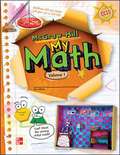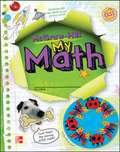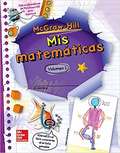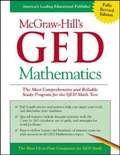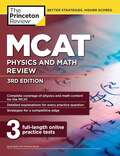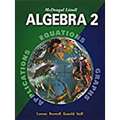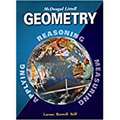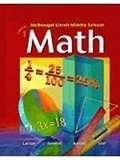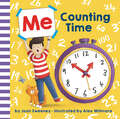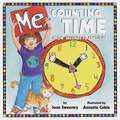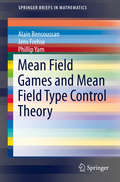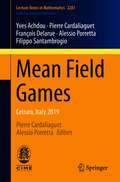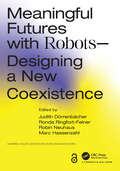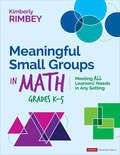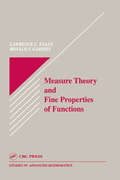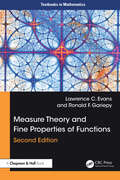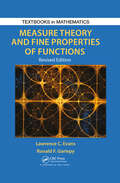- Table View
- List View
McGraw-Hill My Math, Grade 3, Volume 1
by McGraw-Hill EducationThis set provides the consumable Student Edition, Volume 1, which contains everything students need to build conceptual understanding, application, and procedural skill and fluency with math content organized to address CCSS. Students engage in learning with write-in text on vocabulary support and homework pages, and real-world problem-solving investigations.
McGraw-Hill My Math, Grade 4, Volume 1
by McGraw-Hill EducationThis set provides the consumable Student Edition, Volume 1, which contains everything students need to build conceptual understanding, application, and procedural skill and fluency with math content organized to address CCSS. Students engage in learning with write-in text on vocabulary support and homework pages, and real-world problem-solving investigations.
McGraw-Hill My Math, Grade 5, Spanish Student Edition, Volume 1 (Elementary Math Connects)
by McGraw Hill Education StaffNIMAC-sourced textbook
McGraw-Hill's GED Mathematics: The Most Comprehensive and Reliable Study Program for the GED Math Test
by Jerry HowettMcGraw-Hill's GED Mathematics guides you through the GED preparation process step-by-step. A Pretest helps you determine your strengths and weaknesses so you can create a study plan to fit your needs. The following chapters introduce you to math concepts on which hundreds of GED questions are based. Then check your understanding of these ideas with the Posttest, presented in the GED format. You can then see how ready you are for the big exam by taking the full-length Practice Test. McGraw-Hill's GED Mathematics includes: *Clear instructions to show you how to use number grids and coordinate plane grids. *Instruction and frequent practice with the Casio /x-260 calculator. *Problem-solving strategies to help you understand word problems. *Easy-to-follow lessons to develop essential math skills in whole numbers, decimals, fractions, percents, ratios, data analysis, geometry, and algebra.
Mcat Physics And Math Review, 3rd Edition
by The Princeton The Princeton ReviewMCAT Physics and Math Review, 3rd Edition (Graduate School Test Preparation)
Mcdougal Littell Algebra 2: Pupil's Edition
by Ron Larson Laurie Boswell Lee Stiff Timothy D. KanoldAlgebra 2 brings math to life with many real-life applications. Circling the globe are three key aspects of Algebra 2--the equations, graphs, and applications that you will use in this course. They will help you understand how mathematics relates to the world. As you explore the applications presented in the book, try to make your own connections between mathematics and the world around you!
Mcdougal Littell Geometry: Applying, Reasoning, Measuring
by Ron Larson Laurie Boswell Lee StiffGeometry, like much of mathematics and science, developed when people began recognizing and describing patterns. In this course, you will study many amazing patterns that were discovered by people throughout history and all around the world. You will also learn to recognize and describe patterns of your own. Sometimes, patterns allow you to make accurate predictions.
Mcdougal Littell Middle School Math: Course 1
by Larson McDougal-Littell Publishing StaffMcDougal Littell Middle School Math, Course 1
Me Counting Time
by Joan SweeneyHow long is a minute? What is a decade? How many decades are in a century?Now with new illustrations by Alex Willmore, Me Counting Time is a playful introduction to the concept of time. When a young boy prepares for his seventh birthday and counts how many years old he is, he begins on an exploration of the many units of time that are a part of everyday life. Fun to read, easy to understand, and brimming with colorful illustrations, this title joins the other repackages in Joan Sweeney's popular Me...series--Me on the Map, Me and My Place in Space, Me and My Amazing Body, Me and My Family Tree, Me and the Measure of Things, and Me and My Senses.
Me Counting Time: From Seconds to Centuries
by Joan SweeneyHow long is a second? Can you count a minute? What is a decade? How many years are in a century?Me Counting Time can show you! From a second to a minute to an hour to a day — and all the way to a millennium — this playful introduction to time helps children understand the many measurements of time and how they’re used in everyday life. Easy to read and easy to understand, Me Counting Time makes learning a fun time for every child.
Mean Field Games and Mean Field Type Control Theory
by Alain Bensoussan Jens Frehse Phillip YamMean field games and Mean field type control introduce new problems in Control Theory. The terminology "games" may be confusing. In fact they are control problems, in the sense that one is interested in a single decision maker, whom we can call the representative agent. However, these problems are not standard, since both the evolution of the state and the objective functional is influenced but terms which are not directly related to the state or the control of the decision maker. They are however, indirectly related to him, in the sense that they model a very large community of agents similar to the representative agent. All the agents behave similarly and impact the representative agent. However, because of the large number an aggregation effect takes place. The interesting consequence is that the impact of the community can be modeled by a mean field term, but when this is done, the problem is reduced to a control problem.
Mean Field Games: Cetraro, Italy 2019 (Lecture Notes in Mathematics #2281)
by Pierre Cardaliaguet Yves Achdou Filippo Santambrogio François Delarue Alessio PorrettaThis volume provides an introduction to the theory of Mean Field Games, suggested by J.-M. Lasry and P.-L. Lions in 2006 as a mean-field model for Nash equilibria in the strategic interaction of a large number of agents. Besides giving an accessible presentation of the main features of mean-field game theory, the volume offers an overview of recent developments which explore several important directions: from partial differential equations to stochastic analysis, from the calculus of variations to modeling and aspects related to numerical methods. Arising from the CIME Summer School "Mean Field Games" held in Cetraro in 2019, this book collects together lecture notes prepared by Y. Achdou (with M. Laurière), P. Cardaliaguet, F. Delarue, A. Porretta and F. Santambrogio.These notes will be valuable for researchers and advanced graduate students who wish to approach this theory and explore its connections with several different fields in mathematics.
Meaningful Futures with Robots: Designing a New Coexistence (Chapman & Hall/CRC Artificial Intelligence and Robotics Series)
by Marc Hassenzahl Judith Dörrenbächer Ronda Ringfort-Felner Robin NeuhausSoon, robots will leave the factories and make their way into living rooms, supermarkets, and care facilities. They will cooperate with humans in everyday life, taking on more than just practical tasks. How should they communicate with us? Do they need eyes, a screen, or arms? Should they resemble humans? Or may they enrich social situations precisely because they act so differently from humans? Meaningful Futures with Robots: Designing a New Coexistence provides insight into the opportunities and risks that arise from living with robots in the future, anchored in current research projects on everyday robotics. As well as generating ideas for robot developers and designers, it also critically discusses existing theories and methods for social robotics from different perspectives - ethical, design, artistical and technological – and presents new approaches to meaningful human-robot interaction design. Key Features: Provides insights into current research on robots from different disciplinary angles with a particular focus on a value-driven design. Includes contributions from designers, psychologists, engineers, philosophers, artists, and legal scholars, among others.
Meaningful Small Groups in Math, Grades K-5: Meeting All Learners’ Needs in Any Setting (Corwin Mathematics Series)
by Kimberly Ann RimbeyTarget the Math…Support the Students…Provide Access for All The need for focused small group math instruction has never been greater. Today’s education landscape is fraught with learning divides unlike anything we’ve faced in recent years. We need new ways of teaching students who have remarkably varying levels of understanding and vastly different needs. Meaningful Small Groups in Math, Grades K-5 offers practical guidance on how to meet the diverse needs of today’s students. Written for K-5 classroom teachers, math interventionists and instructional coaches, this user-friendly, accessible book provides guidance on the necessary components of small group instruction in math, trajectories for small-group instruction on specific concepts, and practical steps for getting started. Readers will find Checklists and templates for implementing small group, sample lessons in the major content domains Emphasis on flexible groups Intervention and extension ideas for differentiating learning A chapter devoted to developing small-group programs across a school or organization Small group instruction in mathematics has not been as well-developed as its counterpart in the reading world. In K-5 math classrooms, small-group instruction has typically been reduced to learning centers and rotation stations, with little emphasis on differentiated, small-group, teacher-facilitated learning. To meet the needs of today’s students, a more focused approach is needed.
Meaningful Small Groups in Math, Grades K-5: Meeting All Learners’ Needs in Any Setting (Corwin Mathematics Series)
by Kimberly Ann RimbeyTarget the Math…Support the Students…Provide Access for All The need for focused small group math instruction has never been greater. Today’s education landscape is fraught with learning divides unlike anything we’ve faced in recent years. We need new ways of teaching students who have remarkably varying levels of understanding and vastly different needs. Meaningful Small Groups in Math, Grades K-5 offers practical guidance on how to meet the diverse needs of today’s students. Written for K-5 classroom teachers, math interventionists and instructional coaches, this user-friendly, accessible book provides guidance on the necessary components of small group instruction in math, trajectories for small-group instruction on specific concepts, and practical steps for getting started. Readers will find Checklists and templates for implementing small group, sample lessons in the major content domains Emphasis on flexible groups Intervention and extension ideas for differentiating learning A chapter devoted to developing small-group programs across a school or organization Small group instruction in mathematics has not been as well-developed as its counterpart in the reading world. In K-5 math classrooms, small-group instruction has typically been reduced to learning centers and rotation stations, with little emphasis on differentiated, small-group, teacher-facilitated learning. To meet the needs of today’s students, a more focused approach is needed.
Measure Theory and Fine Properties of Functions (Studies In Advanced Mathematics Ser. #5)
by LawrenceCraig EvansThis book provides a detailed examination of the central assertions of measure theory in n-dimensional Euclidean space and emphasizes the roles of Hausdorff measure and the capacity in characterizing the fine properties of sets and functions. Topics covered include a quick review of abstract measure theory, theorems and differentiation in Mn, lower Hausdorff measures, area and coarea formulas for Lipschitz mappings and related change-of-variable formulas, and Sobolev functions and functions of bounded variation. The text provides complete proofs of many key results omitted from other books, including Besicovitch's Covering Theorem, Rademacher's Theorem (on the differentiability a.e. of Lipschitz functions), the Area and Coarea Formulas, the precise structure of Sobolev and BV functions, the precise structure of sets of finite perimeter, and Alexandro's Theorem (on the twice differentiability a.e. of convex functions).Topics are carefully selected and the proofs succinct, but complete, which makes this book ideal reading for applied mathematicians and graduate students in applied mathematics.
Measure Theory and Fine Properties of Functions (Textbooks in Mathematics)
by Lawrence C. EvansThis popular textbook provides a detailed examination of the central assertions of measure theory in n-dimensional Euclidean space, with emphasis upon the roles of Hausdorff measure and capacity in characterizing the fine properties of sets and functions.Measure Theory and Fine Properties of Functions, Second Edition includes many interesting items working mathematical analysts need to know, but are rarely taught. Topics covered include a review of abstract measure theory, including Besicovitch’s covering theorem, Rademacher’s theorem (on the differentiability a.e. of Lipschitz continuous functions), the area and coarea formulas, the precise structure of Sobolev and BV functions, the precise structure of sets of finite perimeter, and Aleksandrov’s theorem (on the twice differentiability a.e. of convex functions).The topics are carefully selected, and the proofs are succinct, but complete. This book provides ideal reading for mathematicians and graduate students in pure and applied mathematics. The authors assume readers are at least fairly conversant with both Lebesgue measure and abstract measure theory, and the expository style reflects this expectation. The book does not offer lengthy heuristics or motivation, but as compensation presents all the technicalities of the proofs.This new Second Edition has been updated to provide corrections and minor edits from the previous Revised Edition, with countless improvements in notation, format and clarity of exposition. Also new is a section on the sub differentials of convex functions, and in addition the bibliography has been updated.
Measure Theory and Fine Properties of Functions, Revised Edition (Textbooks in Mathematics)
by Lawrence Craig Evans Ronald F. GariepyThis book emphasizes the roles of Hausdorff measure and the capacity in characterizing the fine properties of sets and functions. The book covers theorems and differentiation in Rn , Hausdorff measures, area and coarea formulas for Lipschitz mappings and related change-of-variable formulas, and Sobolev functions and functions of bounded variation. This second edition includes countless improvements in notation, format, and clarity of exposition. Also new are several sections describing the p- theorem, weak compactness criteria in L1, and Young measure methods for weak convergence. In addition, the bibliography has been updated.

